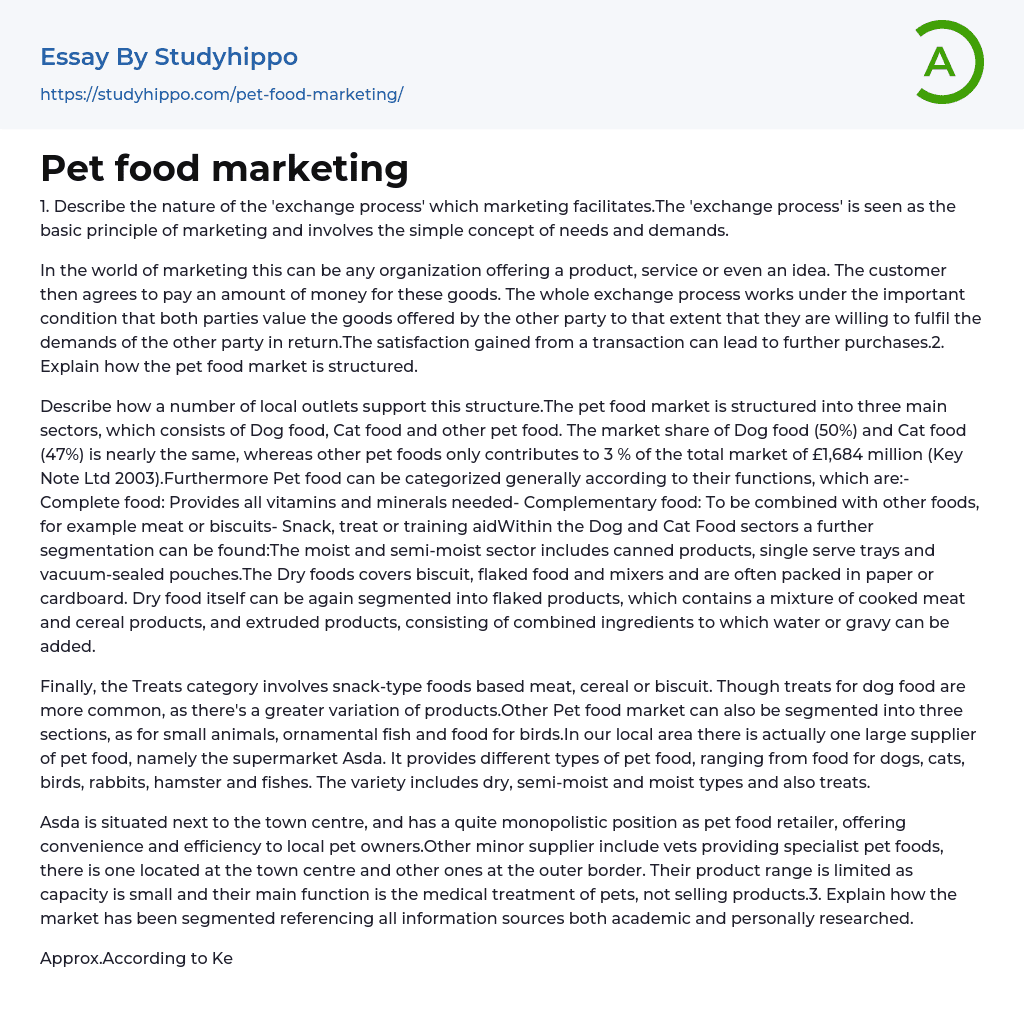1. Describe the nature of the 'exchange process' which marketing facilitates.The 'exchange process' is seen as the basic principle of marketing and involves the simple concept of needs and demands.
In the world of marketing this can be any organization offering a product, service or even an idea. The customer then agrees to pay an amount of money for these goods. The whole exchange process works under the important condition that both parties value the goods offered by the other party to that extent that they are willing to fulfil the demands of the other party in return.The satisfaction gained from a transaction can lead to further purchases.2. Explain how the pet food market is structured.
Describe how a number of local outlets support this structure.The pet food market is structured into three main sectors, which consists
...of Dog food, Cat food and other pet food. The market share of Dog food (50%) and Cat food (47%) is nearly the same, whereas other pet foods only contributes to 3 % of the total market of £1,684 million (Key Note Ltd 2003).Furthermore Pet food can be categorized generally according to their functions, which are:- Complete food: Provides all vitamins and minerals needed- Complementary food: To be combined with other foods, for example meat or biscuits- Snack, treat or training aidWithin the Dog and Cat Food sectors a further segmentation can be found:The moist and semi-moist sector includes canned products, single serve trays and vacuum-sealed pouches.The Dry foods covers biscuit, flaked food and mixers and are often packed in paper or cardboard. Dry food itself can be again segmented into flaked products, which contains a mixture of cooked
meat and cereal products, and extruded products, consisting of combined ingredients to which water or gravy can be added.
Finally, the Treats category involves snack-type foods based meat, cereal or biscuit. Though treats for dog food are more common, as there's a greater variation of products.Other Pet food market can also be segmented into three sections, as for small animals, ornamental fish and food for birds.In our local area there is actually one large supplier of pet food, namely the supermarket Asda. It provides different types of pet food, ranging from food for dogs, cats, birds, rabbits, hamster and fishes. The variety includes dry, semi-moist and moist types and also treats.
Asda is situated next to the town centre, and has a quite monopolistic position as pet food retailer, offering convenience and efficiency to local pet owners.Other minor supplier include vets providing specialist pet foods, there is one located at the town centre and other ones at the outer border. Their product range is limited as capacity is small and their main function is the medical treatment of pets, not selling products.3. Explain how the market has been segmented referencing all information sources both academic and personally researched.
Approx.According to Keynote (2003), 44% of all adults own a pet, and the average age of the owner is about 35-54. This reflects the fact, that pet owners are very likely to be parents with school-age children. A reason for that might be that kids like to have a pet at home as a friend to play with. Also when both parents are in full-time employment, a pet will prevent the children from getting lonely.
Single people are
less likely to own a pet, as they might don't have the time to take care of the pet, or they just prefer to live on their own. When looking at the social status and income of the average pet owner, the statistic shows that people of the Lower Middle Class, C1 and Skilled Working Class (C2) are most likely to have pets, with 53% of all owners belonging to either one of these groups.To explain this phenomenon, we can assume that people with low income cannot afford to keep a pet, and on the other hand, upper class people might not have enough free time to take care of an animal, as most of them are in a high position with great responsibility and a lot of workload. Typically pet owners can be found quite often in the Midlands and North than in the South, although the difference isn't that great with a deviation of only 5%.Recent trends show that men and women are equally likely to own a dog, but women have a greater preference for cats than men do.
Furthermore according to Mintel (2002), amongst people in middle age (35-54), dog ownership is more popular, whereas with increasing age, cat ownership becomes more popular.
- Food Safety essays
- Food Security essays
- Beverages essays
- Cuisines essays
- Dairy essays
- Desserts essays
- Fast Food essays
- Bread essays
- Meal essays
- Meat essays
- Organic Food essays
- Rice essays
- Sugar essays
- Taste essays
- Beef essays
- Coconut essays
- Crowd essays
- Dinner essays
- Juice essays
- Sainsbury essays
- Cooking essays
- Ginger essays
- Oreo essays
- Drink essays
- Beer essays
- Wine essays
- Coffee essays
- Tea essays
- Cake essays
- Hamburger essays
- Ice Cream essays
- Burger essays
- Pizza essays
- Fruit essays
- Lemon essays
- Food Waste essays
- Favorite Food essays
- Alcoholic essays
- Soft Drinks essays
- Cookie essays
- Starch essays
- Yeast essays
- Cola essays
- Pizza Hut essays
- snack foods essays
- chips essays
- Biscuit essays
- Brewing essays
- Brewery essays
- Advertising essays




